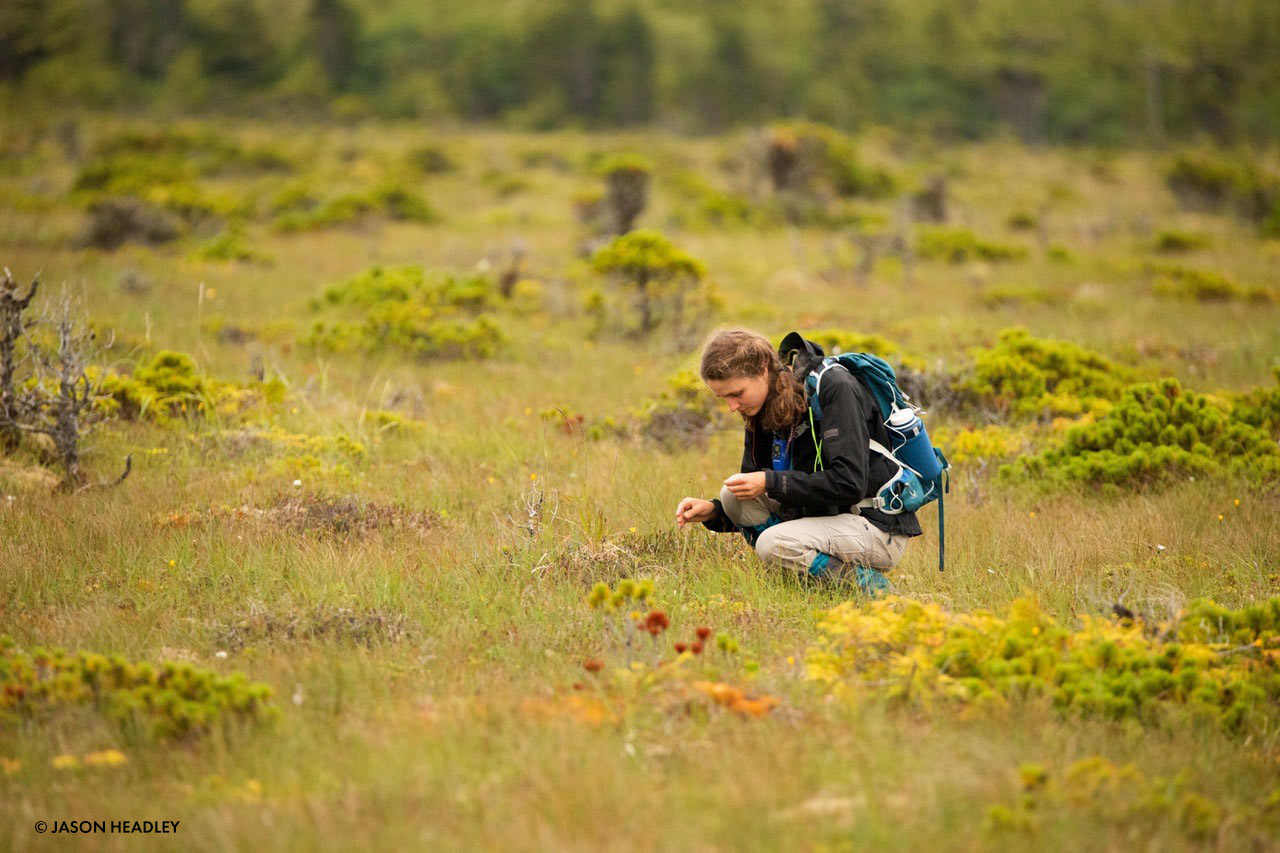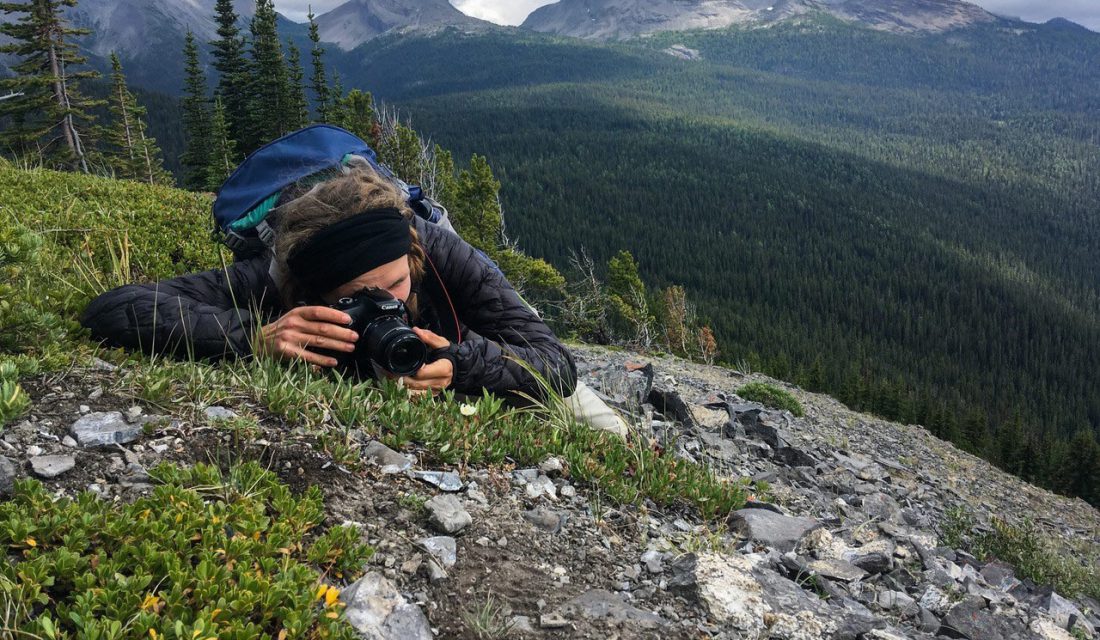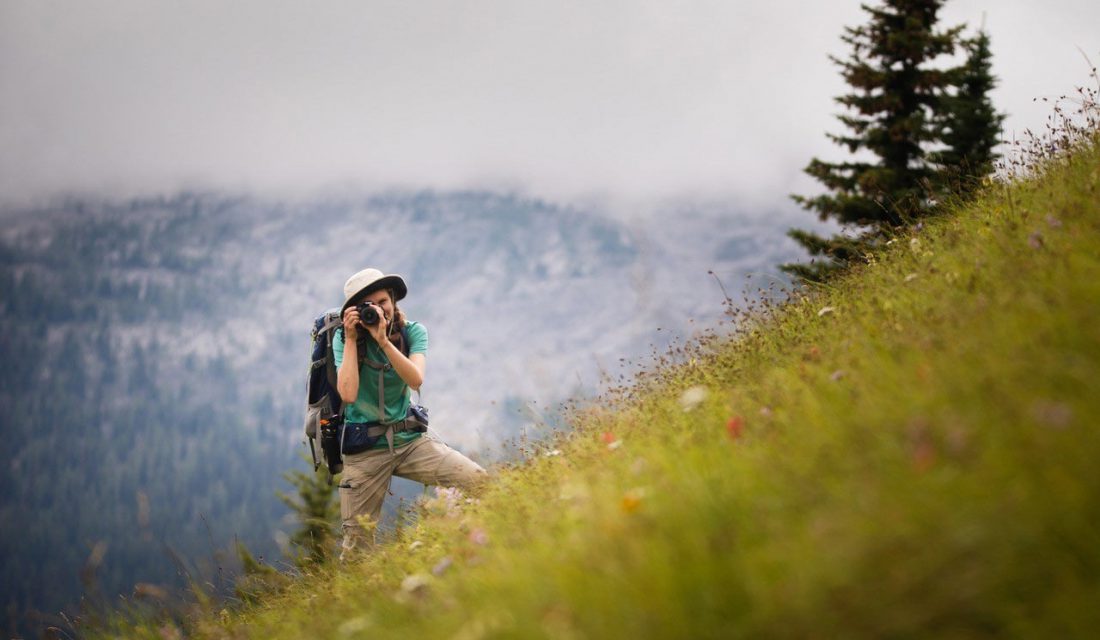Interview With an iNatter

iNaturalist.ca, a platform hosted by the Canadian Wildlife Federation and other partners, recently caught up with an avid iNatter.
(Definition) iNatter:
One who uses the iNaturalist citizen science platform to explore nature and help scientific understanding.
iNatter: Lena Dietz Chiasson

Observing Mountain Avens at Top of the World Provincial Park, BC | © Jason Headley
I am from Sackville, a small town in southeastern New Brunswick. I was lucky to grow up with keen naturalist parents – they sparked my interest in nature from an early age. I love spending time outdoors, be it iNatting, hiking, camping or skiing. Though, I am often sidetracked by the things I find along the way.
I have a background in Geography from the University of Victoria. My particular fondness is for intertidal critters and mountaintop flora, but I do not have any particular expertise. I am currently working a third field season with the BC Parks iNaturalist Project.

iNatting alpine flora in Wells Gray Provincial Park | © Kate McKeown
iNaturalist: When and why did you start using iNaturalist?
LDC: I first started using iNaturalist during a summer student job at Fundy National Park in 2016. My then supervisor (@neilvinson), who is also a big iNaturalist user, strongly encouraged me to use it for park bioblitzes, and as a learning tool. I’ve since used it on my personal time to learn, as well as on a more intense level for work.
iNaturalist: 27,000 is an incredible number of observations! What keeps you interested in iNaturalist?
LDC: When looking at nature, there is always something new! I’ve been lucky to have been collecting the majority of my observations through my work with the BC Parks iNaturalist Project, but it is the learning opportunities, resources and community that iNaturalist provides that keep me interested.
iNaturalist: I see you are an alumna of the Canadian Conservation Corps – were you able to tie your love of iNaturalist into the program?
LDC: Yes, I was part of the fourth cohort (Fourtagers) of the Canadian Conservation Corps program, which was an amazing experience! We only briefly touched on iNaturalist back then, but I from what I hear, it’s become much more popular within CWF since then.

Top of the World Provincial Park, BC, 2019 | © Jason Headley
iNaturalist: What advice would you give to someone who is just starting out using iNaturalist?
LDC: There is too much to share over a few words, but one of the most helpful resources I’ve found is the iNaturalist forum. iNaturalist has a very large and diverse community which I think is one of its biggest strengths, so there are endless tips and advice you can find there. I would also suggest using the website over the app. While the app is a good and simple tool, the website becomes much more useful when you’re exploring the data. I’d also keep in mind that while this is an amazing source of data, it is also an incredible and fun educational tool.
iNaturalist: What is your favourite or most memorable observation that you’ve made and why?
LDC: Ah, this is a difficult question to answer! I see so many things and get really excited about them, until I see another new thing, so my answer will always change. Any firsts of any species for me is usually very exciting. I love looking at tidal pools, so this Sea Clown Triopha is probably one of my favourite finds.
Join the Observation Nation to win prizes for your observations!
Entretien avec une iNatrice

iNaturalist.ca, plateforme hébergée par la Fédération canadienne de la faune et d’autres partenaires, a récemment discuté avec une iNatrice passionnée.
(Définition) iNatrice/iNateur :
Personne qui utilise la plateforme de science citoyenne iNaturalist pour explorer la nature et favoriser la compréhension scientifique.
iNatrice : Lena Dietz Chiasson

Observation de dryades à huit pétales au parc provincial Top of the World en Colombie-Britannique, en 2019. | Photo : Jason Headley
Je viens de Sackville, une petite ville du sud-est du Nouveau-Brunswick. J’ai eu la chance de grandir avec des parents naturalistes passionnés – ils ont suscité mon intérêt pour la nature quand j’étais très jeune encore. J’adore passer du temps au grand air, que ce soit pour iNater ou bien pour faire de la randonnée, du camping ou du ski. Par contre, je me laisse souvent arrêter par les choses que je trouve en chemin.
J’ai fait des études en géographie à l’Université de Victoria. J’ai une prédilection pour les animaux de l’estran et les plantes de haute montagne, mais je n’ai pas d’expertise particulière. Je travaille en ce moment pour une troisième saison de terrain au projet iNaturalist de BC Parks.

Consignation dans iNaturalist de plantes alpines au parc provincial Wells Gray, en 2020. | Photo : Kate McKeown
iNaturalist : Quand et pourquoi avez-vous commencé à utiliser iNaturalist?
LDC : J’ai d’abord commencé à utiliser iNaturalist pendant un travail étudiant d’été au parc national Fundy en 2016. Le superviseur que j’avais alors (@neilvinson), qui est lui aussi un grand utilisateur d’iNaturalist, m’a fortement encouragée (et j’en suis très reconnaissante!) à utiliser cette plateforme pour les bioblitz du parc et également comme outil d’apprentissage. Je l’utilise depuis dans mon temps personnel pour apprendre, de même qu’à un niveau plus intense pour mon travail.
iNaturalist : 27 000, c’est un nombre incroyable d’observations! Qu’est-ce qui maintient votre intérêt pour iNaturalist?
LDC : Lorsqu’on regarde la nature, il y a toujours quelque chose de nouveau! J’ai eu la chance de recueillir la majorité de mes observations dans le cadre de mon travail pour le projet iNaturalist de BC Parks (en anglais), mais ce sont les possibilités d’apprentissage, les ressources et la communauté qu’offre iNaturalist qui nourrissent mon intérêt.
iNaturalist : Je vois que vous avez participé au Corps de conservation canadien. Avez-vous pu intégrer votre amour d’iNaturalist dans le programme?
LDC : Oui, j’ai fait partie de la quatrième cohorte (Fourtagers) du programme du Corps canadien de conservation, et c’était une expérience formidable! Nous avons à peine touché à iNaturalist alors, mais de ce que j’en entends, la plateforme est devenue beaucoup plus populaire au sein de la FCF par la suite.

Parc provincial Top of the World, Colombie-Britannique, 2019. | Photo : Jason Headley
iNaturalist : Quel conseil donneriez-vous à quelqu’un qui vient de commencer à utiliser iNaturalist?
LDC : Il y a trop de choses à présenter pour le faire en quelques mots, mais le forum iNaturalist (en anglais) est l’une des ressources les plus utiles que j’ai trouvées. iNaturalist a une communauté très grande et diversifiée, ce qui est à mon avis l’une de ses plus grandes forces; on peut donc y trouver une quantité infinie de trucs et de conseils. Je recommanderais également d’utiliser le site Web plutôt que l’application. L’appli est un bon outil, simple, mais le site Web est bien plus utile quand on explore les données. Il ne faut pas non plus perdre de vue que, même s’il s’agit d’une source de données formidable, c’est aussi un outil éducatif incroyable et amusant.
iNaturalist : Quelle est votre observation préférée ou bien l’observation la plus mémorable que vous ayez faite, et pourquoi?
LDC : Ah, c’est une question difficile! Je vois tant de choses qui m’intéressent vivement, jusqu’à ce que je voie quelque chose de nouveau, alors ma réponse sera chaque fois différente. Je trouve habituellement très intéressantes les premières observations de quelque espèce que ce soit. J’adore regarder les mares résiduelles sur la côte; ce Triopha catalinae est donc probablement l’une de mes trouvailles préférées.





Comments
Wonderful post! Keep up the wonderful observations @lenachiasson ! :)
Add a Comment